Krautsalat (German Cabbage Salad)
This post may contain affiliate links. See my disclosure policy.
A traditional Krautsalat recipe like you’ll find served in German restaurants and at the Munich Oktoberfest! Crispy, refreshing, and delightfully tangy, this German cabbage salad is the perfect accompaniment to your roasted meats, pork chops, grilled chicken, beef and pork roasts, sausages and more!
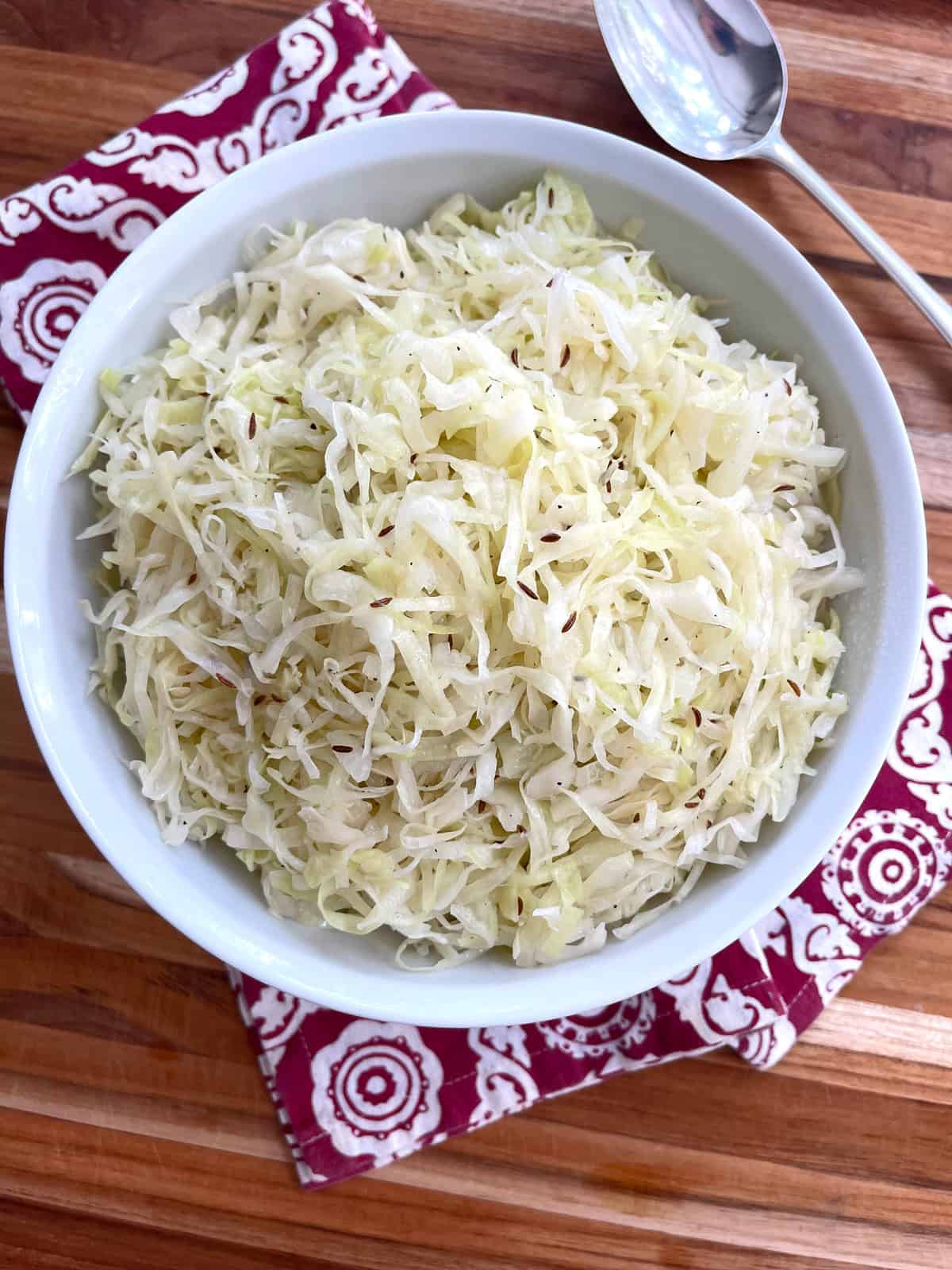
This season saw my best cabbage harvest. I three green varieties, including my beloved Spitzkohl (pointy cabbage) from Germany (for making a ridiculous amount of Sauerkraut – 35 pounds of it so far and counting!), savoy cabbage, and red cabbage (for making lots of Rotkohl and pickled red cabage). And by best cabbage harvest ever, I mean that even after 35 pounds of sauerkraut, 15 pounds of Rotkohl and pickled cabbage, stuffed cabbage rolls, and several large batches of my creamy Cabbage and Kielbasa Soup, I still have 16 heads of cabbage waiting to be processed! Am I cabbaged out? I’m definitely getting there. But first, we need to make a traditional German cabbage side dish called Krautsalat!
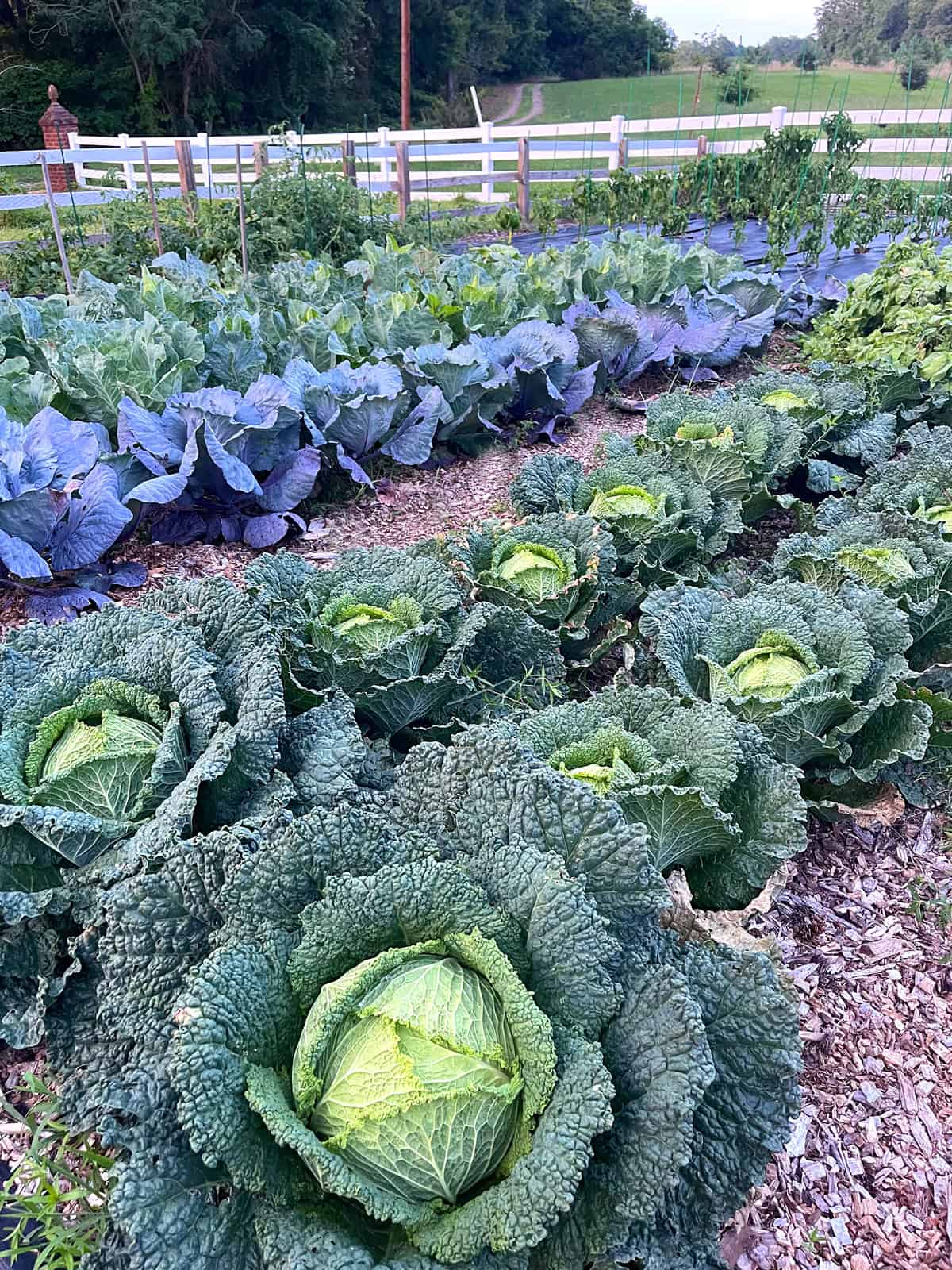
What is Krautsalat?
This German cabbage salad is popular throughout Germany but especially where my Mutti is from in Bavaria and where I’m from in Baden-Württemberg. The cabbage is raw but is massaged until broken down, salted and left for about an hour to draw out the water, and then tossed with a simple vinaigrette featuring caraway seeds. It’s crunchy and tangy and makes a terrific side dish to a number of dishes, especially smoked or grilled meats. As with many things, there are variations of this salad, but this Krautsalat is classic and that one you’ll most commonly find throughout German restaurants and served at the Oktoberfest.
Krautsalat Ingredients & Substitutions
This Krautsalat is easy to make and requires just a handful of ingredients. Here’s what you’ll need to make it:
- Green cabbage: You’ll need two pounds of finished shredded cabbage, which is roughly a medium-sized head. Choose one that is fresh and very firm.
- Yellow onion: I’ve seen some recipes (ones based here in the U.S.) that call for cooking the onions first, but this is not typical, not for a raw salad. For braised green cabbage, yes.
- Salt: I recommend either kosher or sea salt. We use a generous amount of it initially to draw the excess water out of the cabbage. But don’t worry, the cabbage is then rinsed and drained. Some recipes call for soaking the cabbage in salted water and I’ve done it both ways, but a water soak is neither necessary nor advantageous to the final outcome.
- White wine vinegar: made from fermented white grapes, it has a more subtle, fruity, and pleasing flavor. You can add more according to taste. Something I also like to add, as many German cooks do, is a splash or two of Essig Essenz which is very concentrated vinegar and gives the salad a nice little zing. It’s the same vinegar that’s used to finish off the flavors in a lot of German salads including German Potato Salad and Wurstsalat.
- Sunflower oil: sunflower oil isn’t a must but it’s the oil of choice in Germany for many salads. It’s a mild and neutral-tasting oil. You can substitute a different neutral-tasting oil of your choice, such as canola or avocado. –
- Caraway seeds: there is no substitute flavor for caraway seeds. If you don’t like them you can simply omit them.
- Sugar: just a touch for balance and to enhance the overall flavor. You can add more or less according to your taste.
- Salt and pepper: for seasoning.
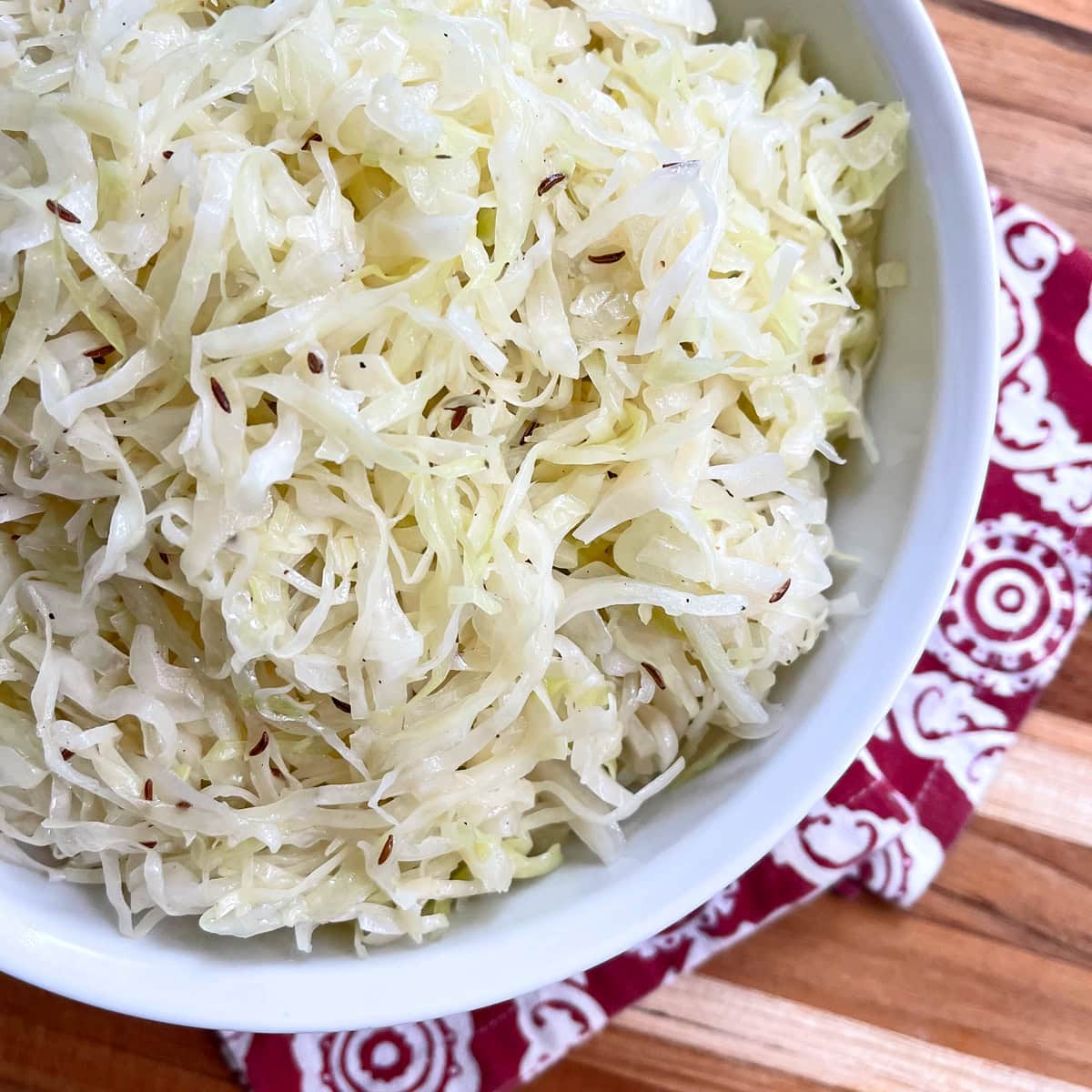
Tips for Making German Cabbage Salad
Texture is key. Krautsalat is all about that crispy-crunchy texture without being saturated with water. And the way to achieve that is three-fold:
- Be sure to very thinly slice/shred the cabbage. You can do this by hand with a large sharp knife or you can use a mandolin for convenience.
- Thoroughly massage the salted cabbage! Your fingers will get tired but keep massaging. You’ll know when you’ve broken it down enough because the volume will be reduce by less than half and you’ll have a pool of cabbage water at the bottom of the bowl. The salt is critical in drawing out the excess water and the massaging helps break down the fibers.
- Thoroughly drain the cabbage after rinsing it. Again, we want to avoid having any excess water. The only liquid that should be in the finished Krautsalat is the vinaigrette.
- For optimal flavor let the Krautsalat chill in the fridge for at least 4 hours before serving. I like it even better the following day.
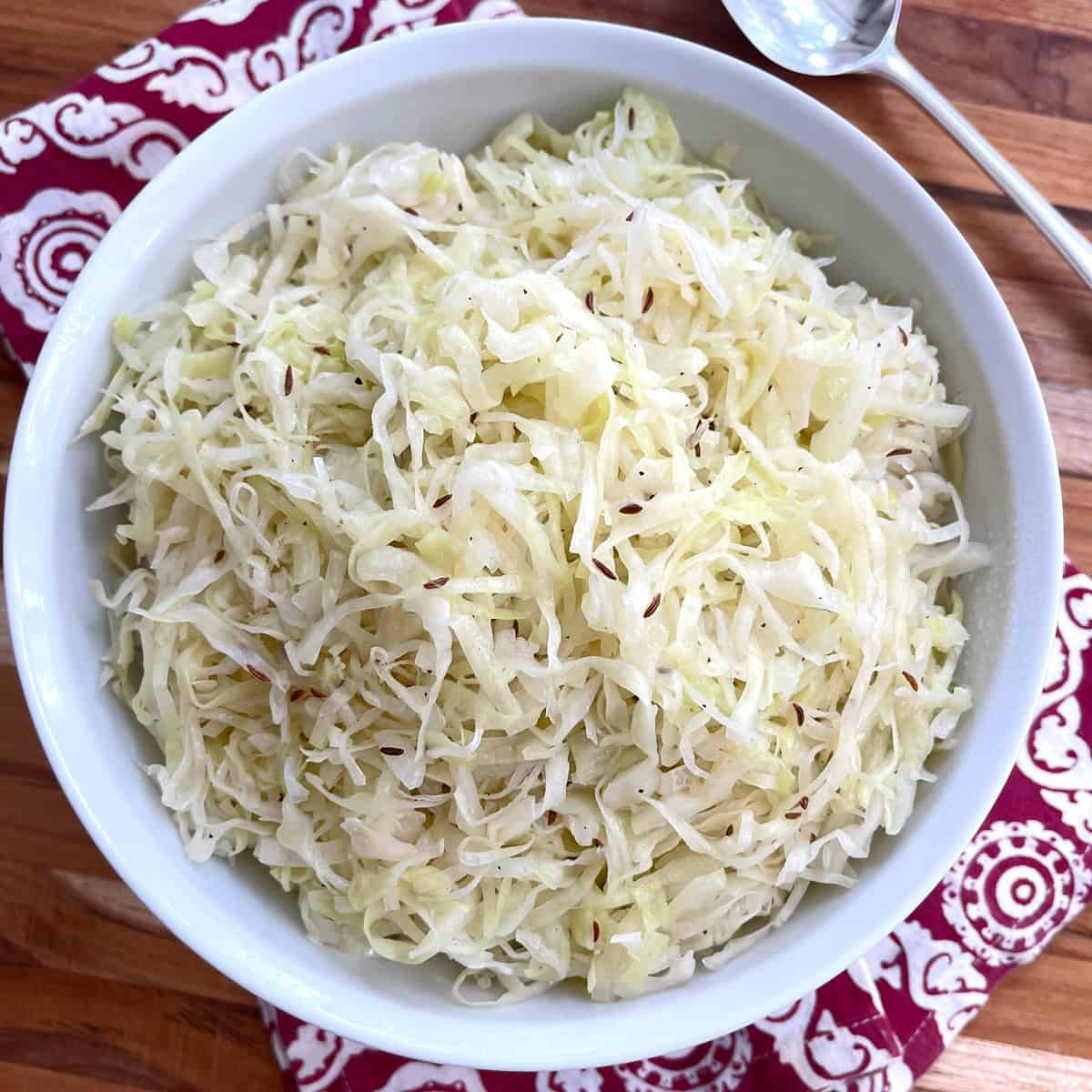
Krautsalat Recipe
Let’s get started!
Remove any rough outer leaves of the cabbage. Remove the core and tough spines. Very thinly shred the cabbage. I use a sharp knife (all that slicing is therapeutic, ha!) but you can also use a mandolin. I don’t like using a food processor because I like those long, thin strands.
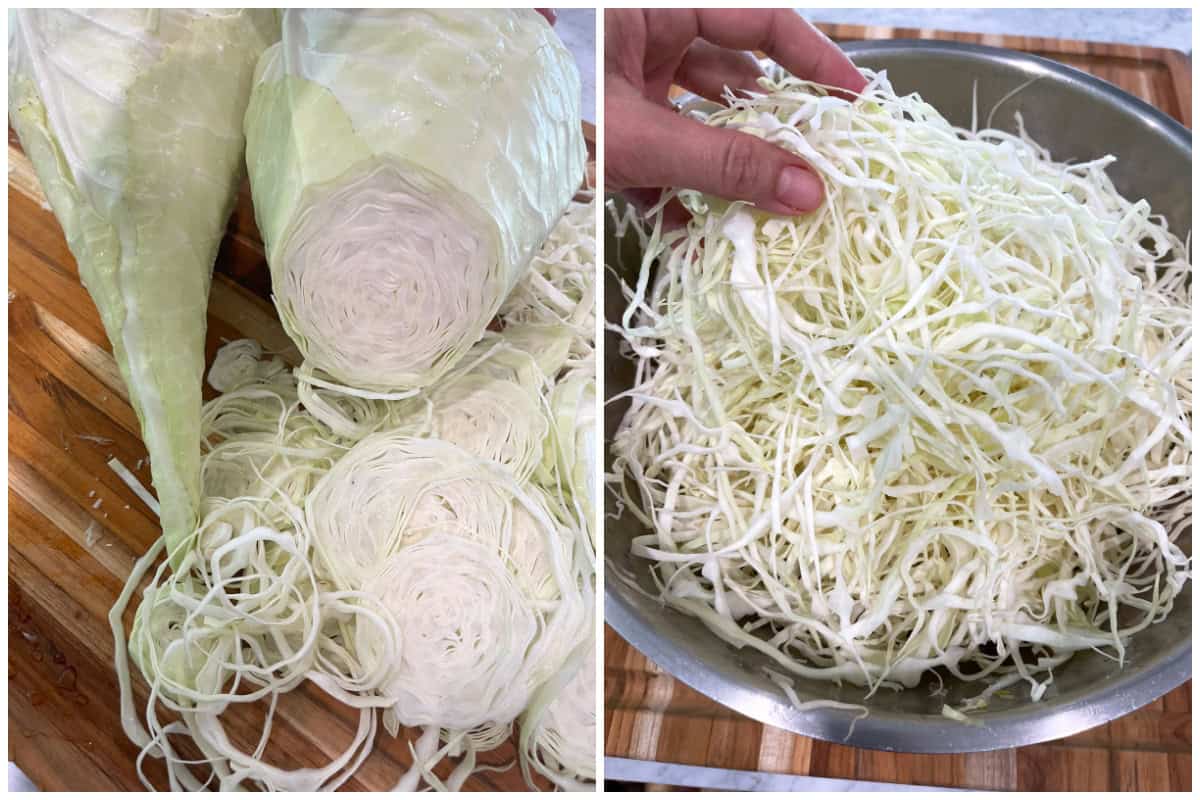
Place the cabbage in a large bowl and add the onions and the salt.
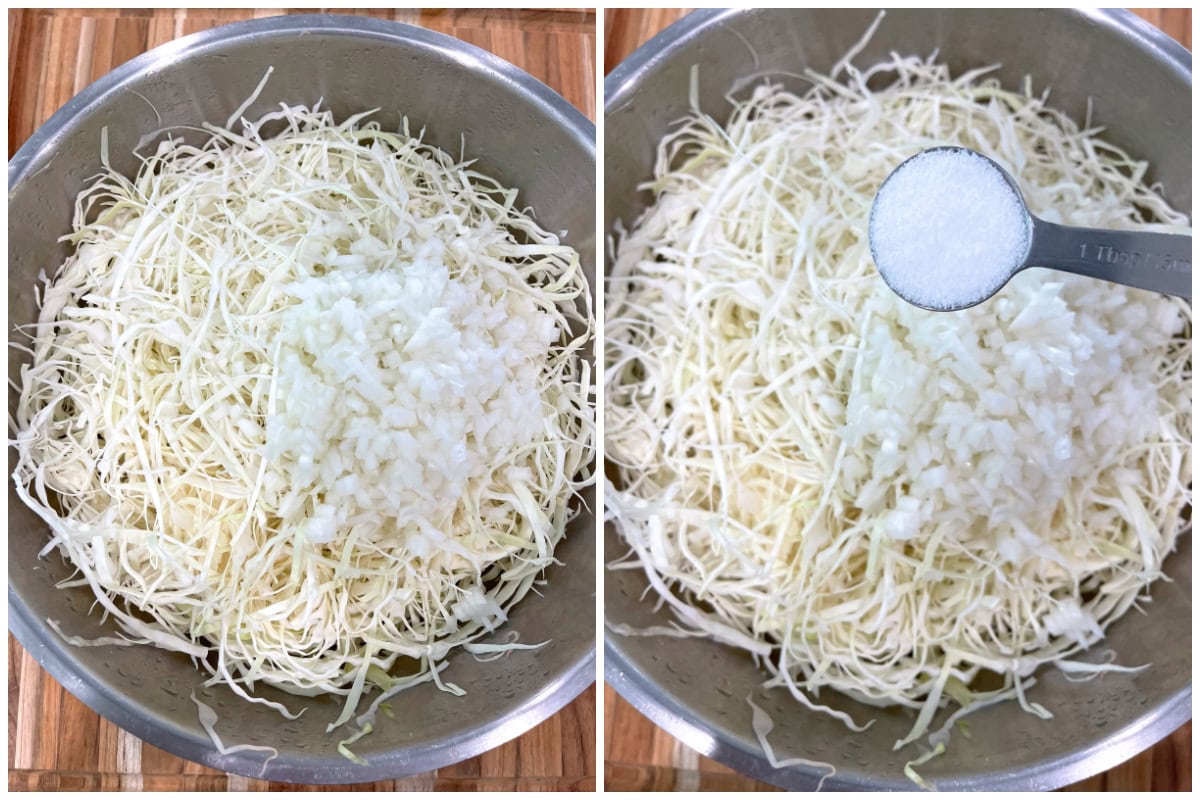
Use your hands to thoroughly massage the cabbage for a few minutes until it’s broken down. The volume should be reduced by almost half and there will be a pool of water at the bottom of the bowl.
Cover the cabbage and let it sit for 30-60 minutes to allow the salt to draw out the excess water.
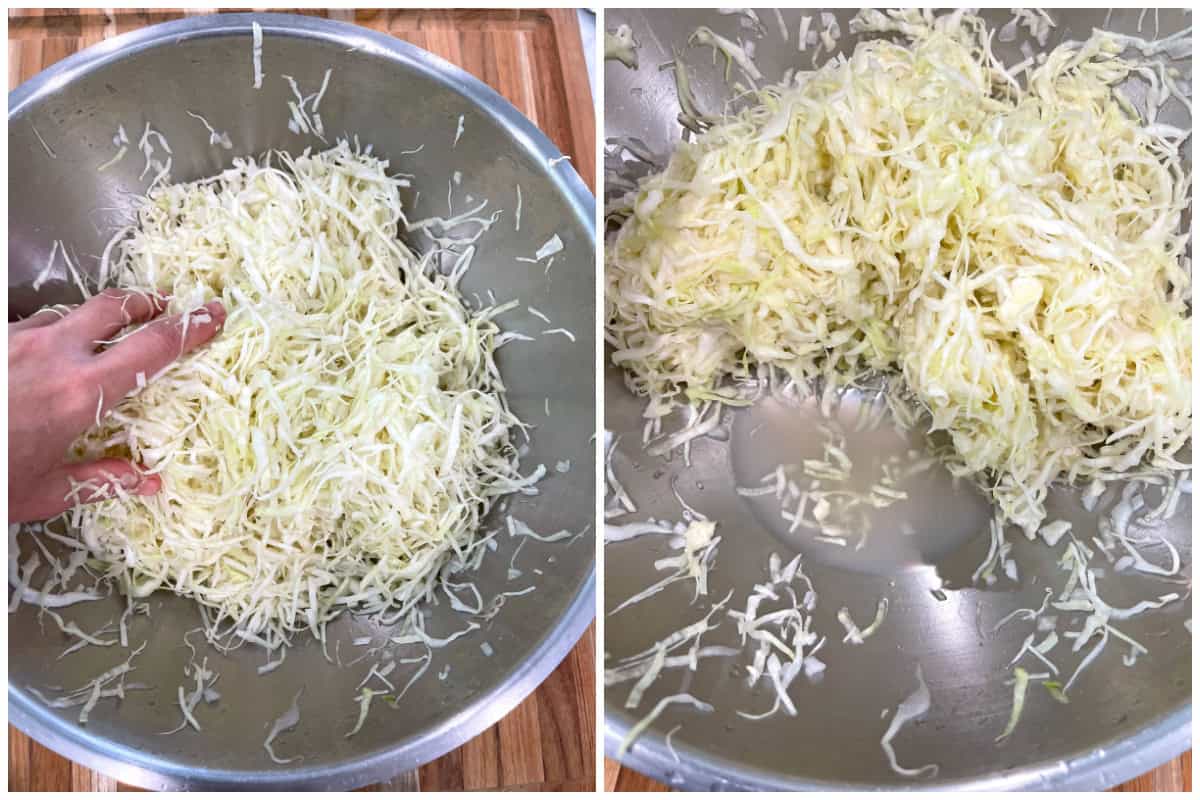
Place the cabbage in a colander and give it a thorough rinse.
Let it drain in the colander for another 30 minutes, squeezing out as much of the water as you can.
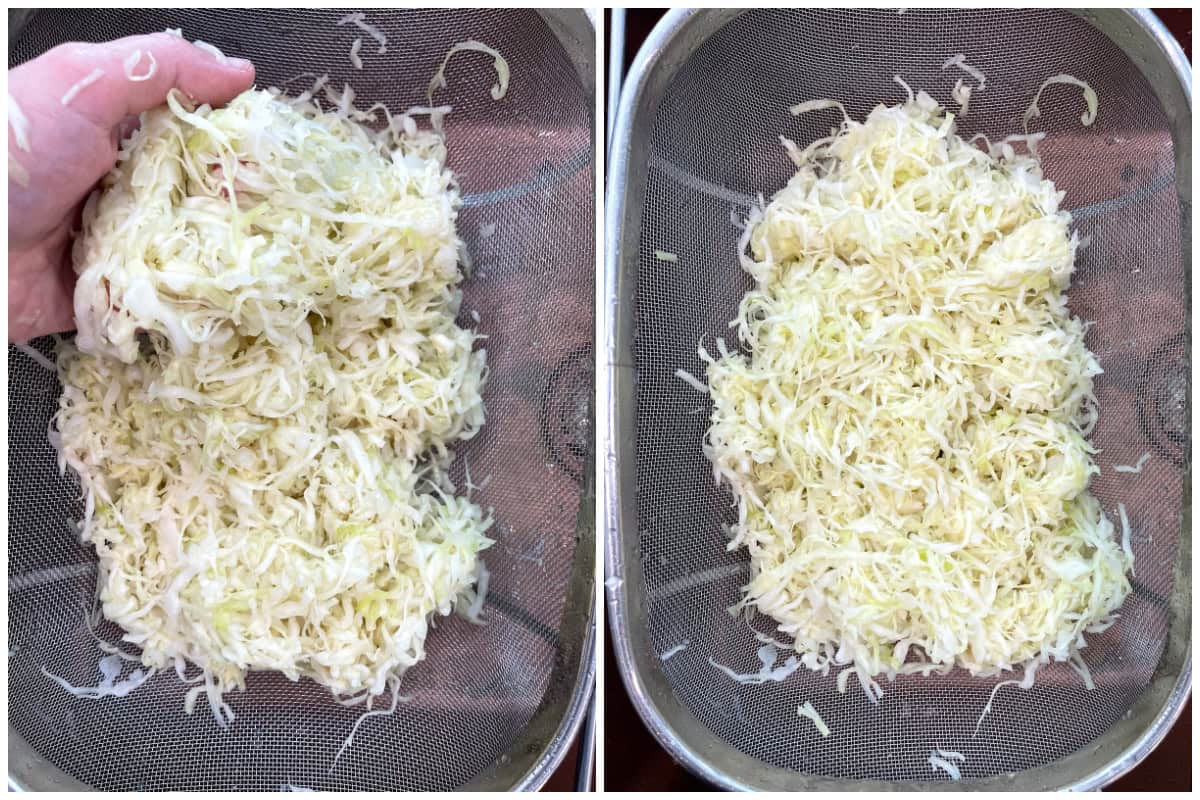
To make the vinaigrette, place all of the ingredients in a small bowl and whisk to combine.
As mentioned earlier, I like to add a splash of Essig Essenz, a very concentred vinegar that’s commonly used in a lot of German salads. It’s optional but it gives the vinaigrette a really nice zing and cuts through the other flavors.
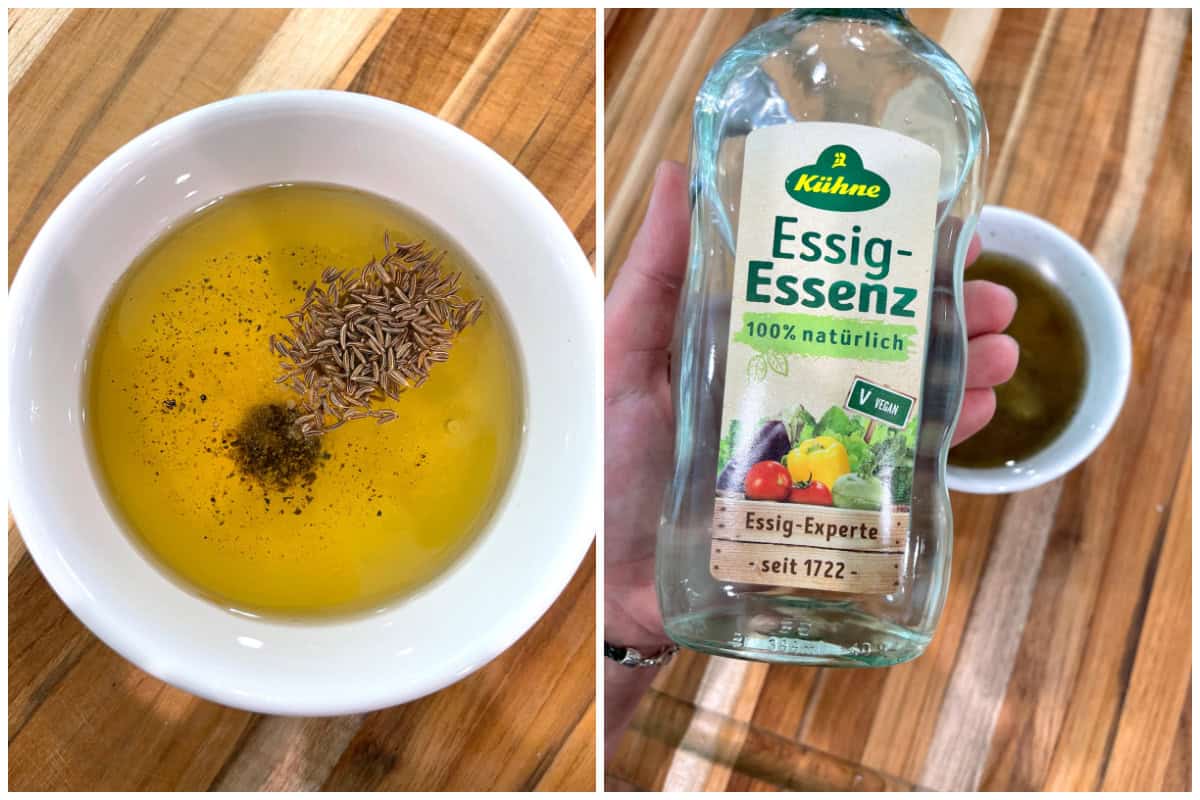
Place the drained cabbage in a large bowl. Pour the vinaigrette over the cabbage and stir to thoroughly combine.
Cover and refrigerate the Krautsalat for at least 4 hours for optimal flavor.
Storage
This German cabbage salad will keep covered in the fridge for 2-3 days. Beyond that it’s still edible but will become discolored.
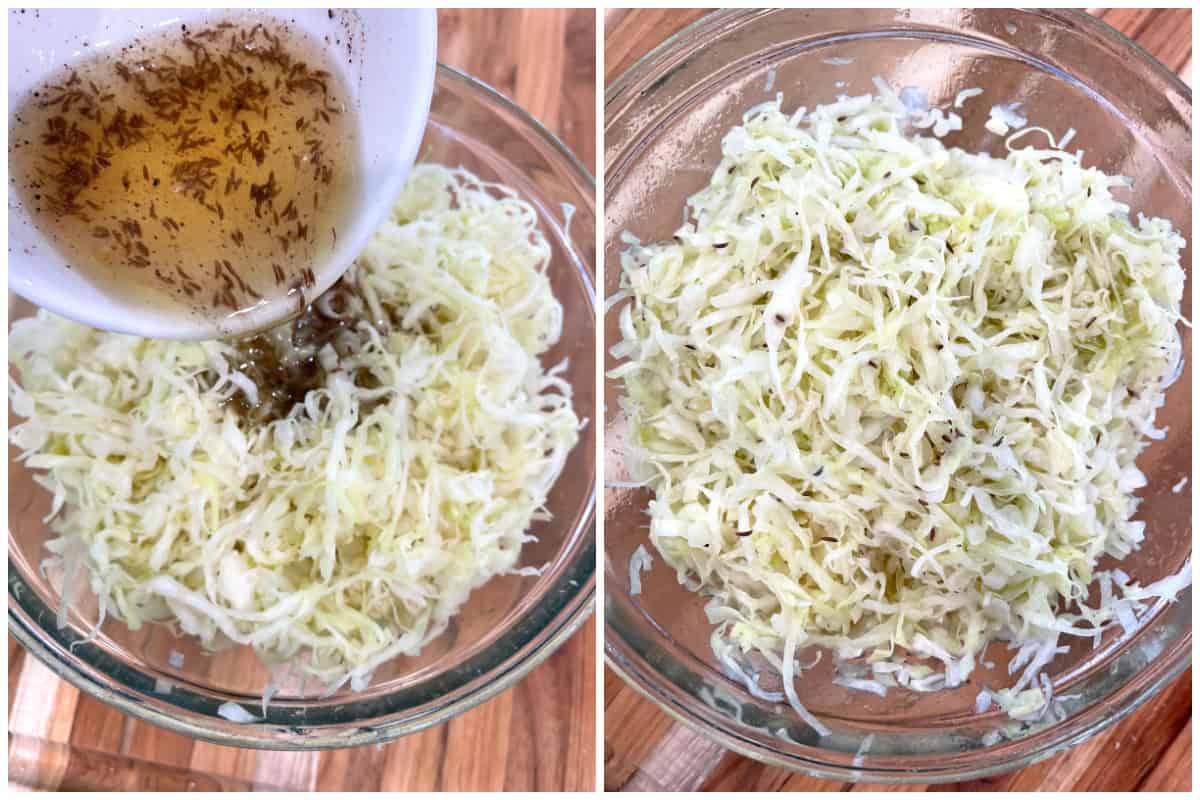
How to Serve Krautsalat
Krautsalat can be served either chilled or at room temperature. In German restaurants it’s most typically served at room temp. It’s often served as it’s own side dish or, also very commonly, as part of a Salatteller (salad plate) which features a combination of different salads (leafy greens, potato salad, carrot salad, radish salad, cabbage salad, etc). This German cabbage salad makes an ideal side for many meat dishes. Here are a few dishes you can serve it with:
- Grilled meats like Schweinshaxe, the quintessential Bavarian Oktoberfest dish. The fresh, crunchy texture and tanginess of the vinaigrette pairs beautifully with roasted meats.
- Beef roasts or pork roasts such as Sauerbraten and Senfbraten.
- German meatloaf or meatballs such as Frikadellen and Königsberger Klopse.
- German Pork Chops, Schnitzel, Jägerschnitzel and Schnitzel Sandwich.
- German Goulash and Rouladen.
- Burgers and hot dogs.
- German sausages like Bratwurst, Rote Wurst, Bratwurst with Mushroom Gravy, and Currywurst.
- Abendbrot (a light evening meal) or lunch with sandwiches or simply some good German Bread or rye bread and Wurstsalat.
- Pair it with other traditional German sides like German Potato Salad, German Cucumber Salad, Creamy German Cucumber Salad, German Carrot Salad, Bohnensalat, Spaetzle, German Potato Dumplings and Semmelknödel.
Enjoy!
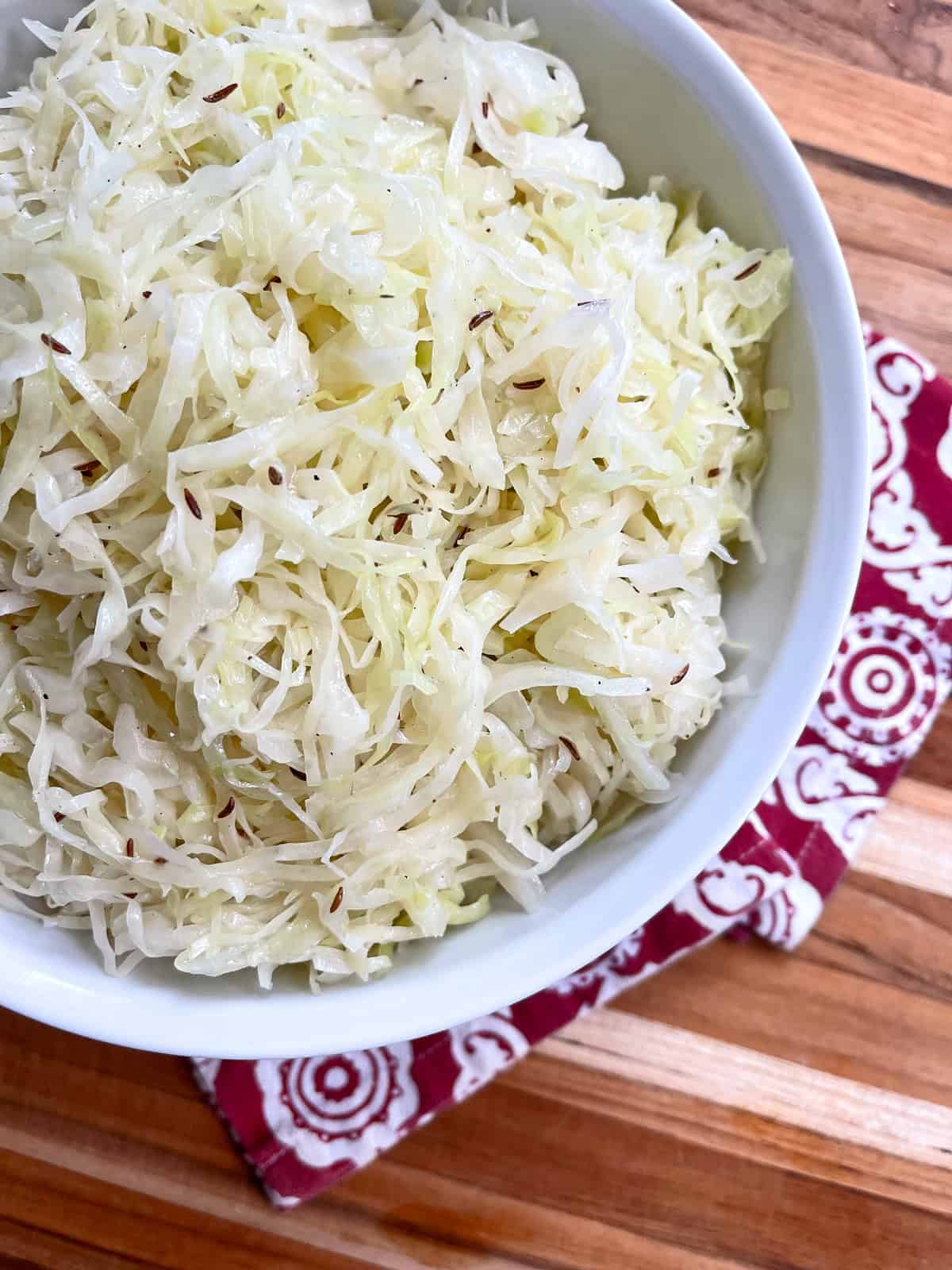
Save This Recipe
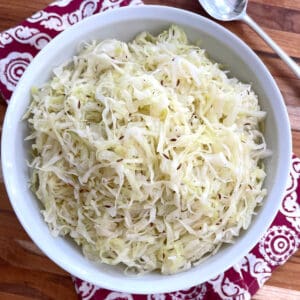
Krautsalat (German Cabbage Salad)
Equipment
Ingredients
- 2 pounds very finely shredded green cabbage , about one medium sized cabbage; rough outer leaves, core and tough spines removed
- 1 small yellow onion , very finely chopped (about 3/4 cup)
- 3 tablespoons kosher or sea salt
- 1/3 cup white wine vinegar
- 1-2 tablespoons Essig Essenz (25% concentrated white vinegar), optional but recommended; otherwise can substitute distilled white vinegar
- 1/3 cup sunflower oil , or neutral salad oil of choice (e.g. canola or avocado)
- 1 teaspoon caraway seeds
- 1 teaspoon white sugar
- 1/2 teaspoon kosher or sea salt
- 1/4 teaspoon freshly ground black pepper
Instructions
- Place the finely sliced cabbage in a large bowl and add the onions and the salt. Use your hands to thoroughly massage the cabbage for a few minutes until it's broken down. The volume should be reduced by almost half and there will be a pool of water at the bottom of the bowl. Cover the cabbage and let it sit for 30-60 minutes to allow the salt to draw out the excess water.Place the cabbage in a colander and give it a thorough rinse.Let it drain in the colander for another 30 minutes, squeezing out as much of the water as you can.
- To make the vinaigrette, place all of the ingredients in a small bowl and whisk to combine.Place the drained cabbage in a large bowl. Pour the vinaigrette over the cabbage and stir to thoroughly combine. Cover and refrigerate the Krautsalat for at least 4 hours for optimal flavor. You can serve it cold or at room temperature.Store in the fridge where it will keep for 2-3 days. It's still edible beyond that but the cabbage will become discolored.



















This takes time, but is completely rewarding. Kimberley knows what she is doing here. Lots of other recipes also call for Speck, but it is actually not needed. This recipe is spot on, the taste very authentic. The caraway flavour is not something that non-Germans are used to, so can consider taking it it easy with that, but if you do it a few times you will learn to judge it. This goes well with roasts and a lot of the other German dishes you can find recipes for here.
Thank you so much for the feedback and compliment, Thomas, I’m happy that you enjoyed this! <3
Super recipe! I had completely forgotten about Krautsalat until I saw this. I’m really glad I did, this will be a new staple.
Fantastic, thank you so much Zac!
This was yummy, such a great way to use up green cabbage and definitely a salad I will make again!
I’m so glad you enjoyed, Trish, thank you!
This was delicious and just as I remember the Krautsalat we used to eat when we were stationed in Germany. Danke!
Bitte schön, Emma, I’m so glad you enjoyed it!
I always have a hard time figuring out what to do with leftover cabbage and I thought I’d give this a try. It was easy so really delish! Really nice, refreshing side dish, will definitely make this again.
I’m so glad you enjoyed it, thank you Sandy! :)